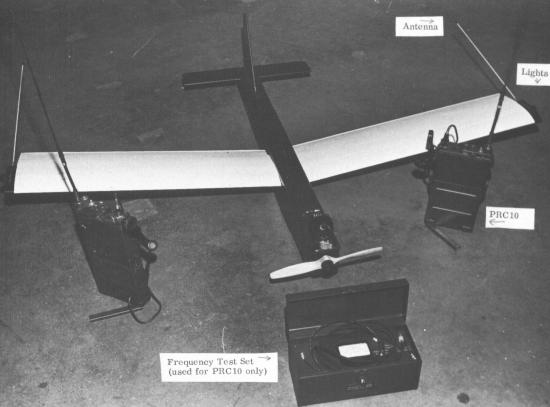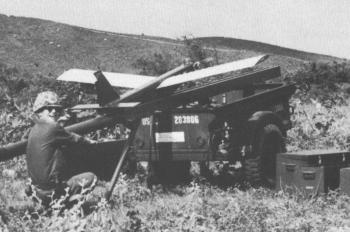Republic Bikini
In 1965, Republic received a contract from the U.S. Marine Corps to develop the Bikini light-weight drone reconnaissance system for battlefield surveillance. Operational tests of the Bikini system were conducted during July/August 1966.
 |
| Photo: Republic |
| Bikini |
The Bikini drone, which did not receive any official military designation, was a small light-weight airplane powered by a single 3.3 kW (4.5 hp) two-cycle piston engine. It was launched from a pneumatic catapult and recovered by parachute. In flight, the Bikini was tracked by radar and controlled via radio commands. The operational range was about 16 km (10 miles) and the drone had an endurance of 30 minutes at a speed of 130 km/h (80 mph). The mission payload consisted of a Fairchild 70mm still picture camera, which could take up to 80 photographs. The Bikini system also included a film processor/viewer and an enlarger/printer, and the photographs could be ready for examination within 30 minutes after drone recovery.
 |
| Photo: Republic |
| Bikini |
A total of about 50 Bikini drones were delivered by Republic between 1965 and 1967. During 1967, the system was briefly deployed to Vietnam, but it was eventually taken out of service in the early 1970s.
Specifications
Note: Data given by several sources show slight variations. Figures given below may therefore be inaccurate!
Data for Bikini:
| Length | 1.93 m (6 ft 4 in) |
| Wingspan | 2.44 m (8 ft) |
| Weight | 27 kg (60 lb) |
| Speed | 130 km/h (80 mph) |
| Ceiling | 3000 m (10000 ft) |
| Range | 16 km (10 miles) |
| Endurance | 30 min |
| Propulsion | Two-cycle piston engine; 3.3 kW (4.5 hp) |
Main Sources
[1] Joshua Stoff: "The Thunder Factory", Motorbooks Intl., 1990
[2] James J. Haggerty (ed.): "1970 United States Aircraft, Missiles and Spacecraft", National Aerospace Education Council, 1970
Back to Directory of U.S. Military Rockets and Missiles, Appendix 4
Last Updated: 5 May 2004